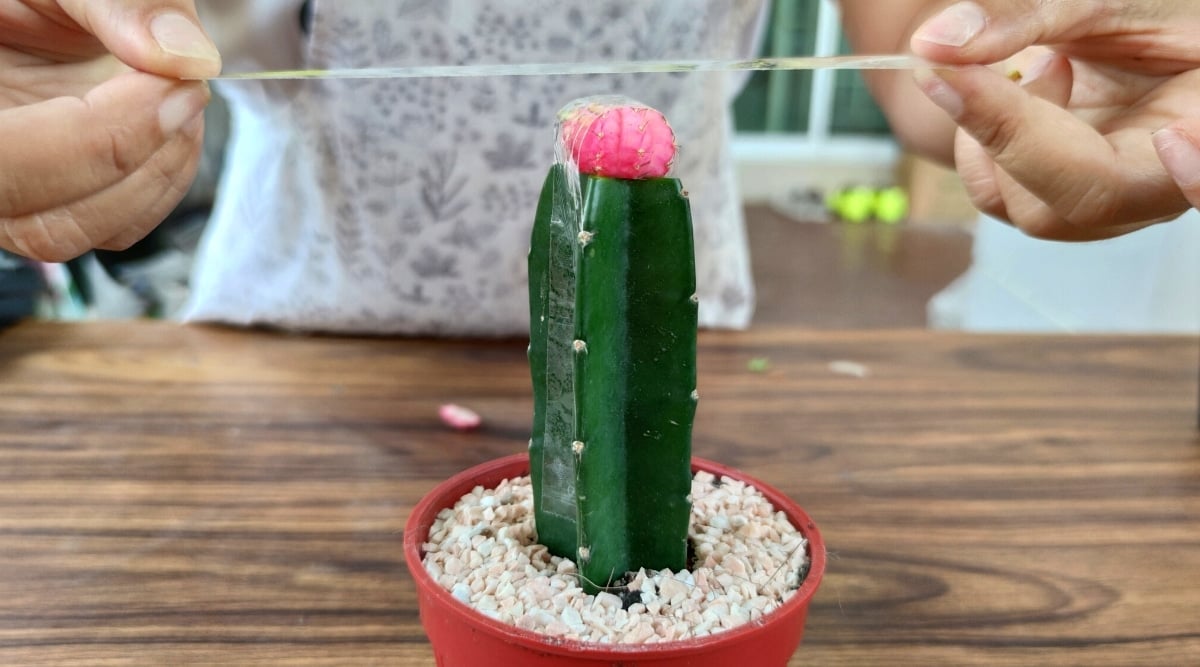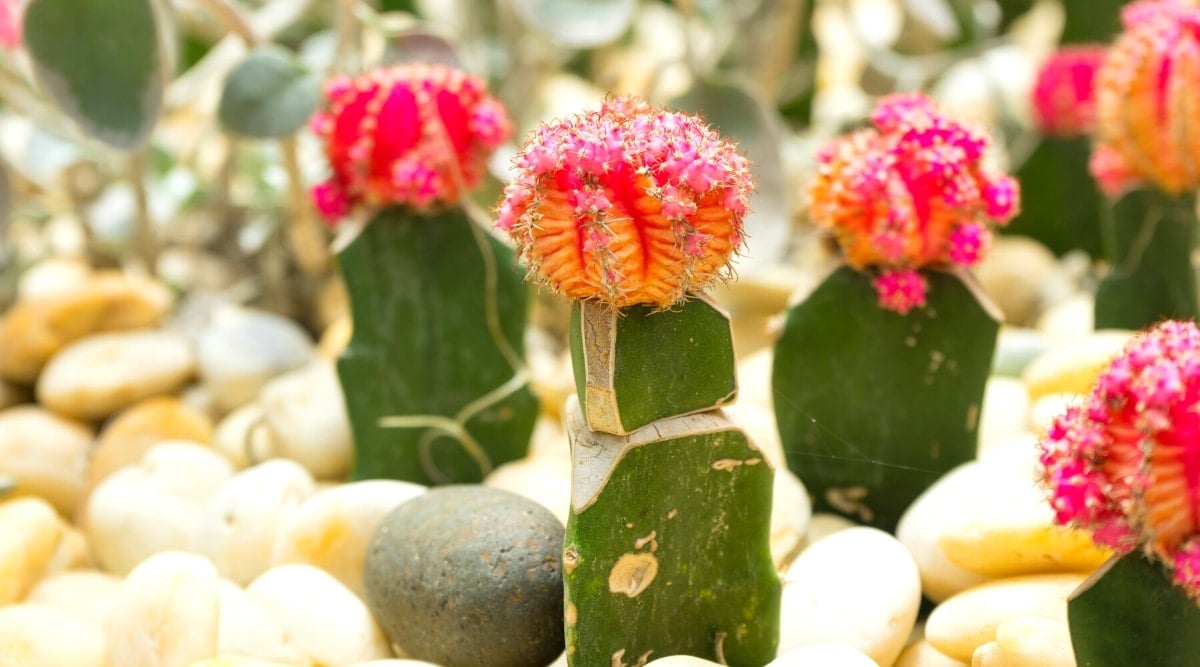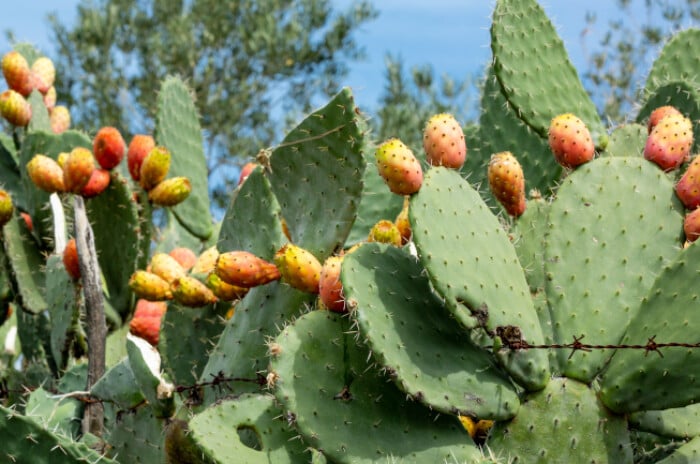How to Plant, Grow, and Care For Moon Cactus
Thinking of adding some moon cactus to your indoor or outdoor garden? These popular cacti have beautiful tops to the plant which come in a variety of colors. In this article, gardening expert Madison Moulton examines how to grow Gymnocalycium mihanovichii, including all aspects of their maintenance and care.

Contents
If you’re looking for a cactus guaranteed to catch someone’s eye, look no further than the moon cactus. This small cactus blooms luminescent colors from orange to pink and more, these plants almost look unreal.
The moon cactus has an interesting origin story and fascinating growth habit that make it completely unique in the succulent and cacti world. Thanks to their native habitats, they don’t need as much sunlight as other plants in this group, making them ideal houseplants.
Read on to learn more about the interesting moon cactus, what makes these plants so special, and how you can take care of them.
Moon Cactus Overview

|
Plant Type
Cactus
Family
Cactaceae
Genus
Gymnocalycium
Species
Gymnocalycium mihanovichii
|
Native Area
Paraguay to Argentina
Hardiness Zones
9-11
Exposure
Bright indirect light, some direct sun
Height
2-12”
|
Watering Requirements
Low
Pests and Diseases
Spider mites, mealybug, aphid
Maintenance
Low
Soil Type
Cactus mix
|
All About Moon Cacti

Moon cactus plants are incredibly easy to spot in a line-up of succulents. They are known for their almost-neon colorful tops, bulbous and covered in spines. In my childhood, I always assumed these cacti were fake due to their luminous colors, but they are 100% real.
Gymnocalycium mihanovichii has an interesting origin story. The species is originally from South America, concentrated around Paraguay and Argentina. However, it looks very different from the plant you may recognize.
You may be surprised to know these plants are naturally green. Mutations that emerged in their cultivation led to the range of stunning colors we see today. You can find this cacti blooming in orange, bright red, yellow, and even pink.
This mutation is the result of a complete lack of chlorophyll in the plant, causing the other pigments within the cells to stand out. Lack of chlorophyll also comes with a damning consequence – moon cacti cannot grow on their own. They need to be grafted to another succulent that does contain chlorophyll in order to survive.
That’s why you’ll always see the colorful tops of moon cacti attached to a green base. These are typically Hylocereus species but they can be attached to a number of plants. Once attached, the base of the plant will do most of the work to keep the top looking pretty.
Are They Hard to Grow?

This arrangement does come with a few downsides. Firstly, although cacti are known as tough plants, moon cacti are slightly more sensitive. Care is also difficult as you have to manage the lighting needs of two different species in one.
Finally, they are not known to live very long. You’ll likely have your moon cactus for around a year, or slightly longer in perfect conditions.
Despite these negatives, they are still wonderful plants to add to your succulent collection. Their color is unmatched, made even more impressive when they flower.
This cactus is also great for indoor growth, which can be tricky for other succulent species. And they make wonderful gifts if you do get the chance to propagate your own.
Planting

Moon cacti love to be squashed into their containers. Like other succulents, they don’t like empty space around their roots and grow far better when confined. That means your moon cactus will be happy in the pot it came in, usually not needing repotting for several years.
If you want to change containers to something more decorative, you can follow the repotting advice below. Keep the container small to avoid potential rotting and make sure the new container has plenty of drainage holes.
You can also use a slightly larger container as a cover instead to add a decorative element without needing to repot. If this container doesn’t have drainage holes, make sure you remove the inner container first to water. This stops water from collecting at the base and leading to rot.
For some decorative flair, add a layer of fine gravel to the top of the soil. Choose a color that matches the plant for added attention to detail.
How to Grow
Moon cactus is not difficult to grow or care for. Like other cacti, this popular houseplant needs very little attention to stay alive.
However, it’s important to keep in mind that it usually won’t grow much or survive for very long due to the colorful mutation. If the plant begins to struggle after a while, it may not necessarily be the result of incorrect care but simply the short lifespan.
Light

Sunlight is probably the most difficult of all the care factors to manage. Thanks to their mutations, the top part of your moon cactus will be extra sensitive to the direct sun, while the bottom part needs more light for photosynthesis. Finding a balance between the two is the only way to keep the plant happy.
This is why moon cacti are typically kept as indoor plants only. Here they can be protected from harsh direct sun while receiving enough light to stay alive. In warmer climates, they can grow outdoors, but you will need to keep a close eye to prevent any chances of burning.
The best position for these plants is a spot with a few hours of direct sunlight and the rest of the day in bright but indirect sunlight. This ensures the base gets enough sunlight for photosynthesis without risking burning the top half.
Water

Your moon cactus needs very little water to survive, even during peak growth. Tons of water is stored in the plant structures for maintenance in periods of drought. They far prefer less water than more as the roots and base of the plant are sensitive to rotting in constantly moist soil.
Depending on the size of your moon cactus, you’ll likely only need to water once every couple of weeks. The soil should be left to dry out completely before watering again. If it has only just dried out, you should wait a few more days before you consider watering again.
In the winter months, avoid watering at all. These plants use very little water when temperatures are low. Watering often in winter will expose your moon cactus to the risk of rotting, a deadly issue if not controlled early.
Water the soil thoroughly until the excess runs through the drainage holes. Make sure all areas are covered. This quick drench replicates the heavy but infrequent rains in their native habitats. Then place the plant back in its previous spot and hold off on watering for at least two weeks.
If your moon cactus is placed in a decorative pot cover, always remove it before watering. Just a few hours of excess moisture around the base can encourage fungal growth and rotting, potentially killing the plant.
Soil

Well-draining soil is essential if you want to keep your moon cactus alive. Luckily, you won’t need to consider soil choice unless you are replanting or repotting. Otherwise, your plant will be happy in the soil it came in for several years.
If you are considering repotting, take a look at the characteristics of the existing soil. You’ll find the texture is sandy and gritty with large spaces between the particles. Replicating this is key to the continued survival or your plant.
The easiest option is to buy a premade succulent and cacti potting mix. These contain the perfect ratios of ingredients to improve drainage and prevent root rot. If you want to make your own, you can amend a high-quality potting mix with additional horticultural sand for the desert-like soil conditions these plants are used to.
Moon cacti don’t use many nutrients to sustain themselves. These slower growers are happiest when the soil is slightly lower in nutrients, so avoid mixing in any compost or fertilizers when planting.
Temperature and Humidity

In the native habitat of Gymnocalycium mihanovichii, temperatures remain relatively warm year-round. These plants are used to hot and bright conditions, not at all tolerating cold temperatures or frost. Luckily, the temperatures found inside our homes are generally perfect for these plants – another reason why we choose to grow them indoors.
Moon cacti don’t appreciate sudden changes in temperature or cold drafts from open windows. In winter, it may be better to move them away from windows to avoid the areas where cold collects. Keeping this plant in the warmest room of your home will deliver the best results.
When it comes to humidity, moon cactuses generally prefer drier air to high humidity. However, they won’t suffer much if the humidity is higher than what they are used to. Just keep an eye out for problems with disease and fungal growth when moisture levels in the air are higher than usual.
This tolerance for lower humidity makes these plants ideal for areas of your home where other tropical houseplants struggle to grow.
Fertilizing

Accustomed to poor-quality soil in their native habitats, moon cactuses don’t typically require fertilizing. They will be happy in their existing pots until they require a soil change to replenish those nutrients and improve drainage.
However, if you want to promote flowering in your plant, you can apply a succulent-specific fertilizer once per year in spring. Use a low concentration and never apply more often than recommended to avoid damage to the root system.
Along with feeding, make sure the light levels are high enough to promote flowering, or your fertilizer won’t be much help.
Propagation
Gymnocalycium mihanovichii propagation is a different process from other succulents and cacti. As these colorful plants cannot live on their own, propagation involves grafting onto a succulent rootstock for continued growth. But, if you have the right tools and a plant ready for the process, it isn’t tricky to do.
Step 1: Identify a Pup

The first step in the process is to identify a pup ready for propagation. These are the smaller balls that emerge from the base of the cactus. They only appear when the growing conditions are right so make sure your care routine is followed if you’re interested in propagating.
Pups ready for removal should be relatively large. The base will be removed, so aim for one large enough to trim without losing too much of the rounded shape.
Step 2: Twist it Off

Next, get ready to remove that pup and any others that appear ready to grow on their own. To pull them off, simply twist in opposite directions until the ball is removed.
You don’t need to worry about gloves as the spines aren’t very sharp but consider extra protection if you have sensitive skin.
Step 3: Cut the Rootstock and Pup

For most cacti, you would simply plant this pup in its own pot to continue growing. But, as we already know, it’s not that simple for moon cacti. You’ll need to choose a rootstock and get ready to graft both plants together.
In nurseries, most growers use Hylocereus undatus (recently reclassified Selenicereus undatus) which you may know as dragon fruit. The stems of this plant make wonderful rootstock that is perfectly sized, but they don’t live longer than a few years. Some prefer Myrtillocactus geometrizans for their longer lifespan.
With your chosen rootstock and pup at the ready, make a horizontal cut at the top of the rootstock and the base of the pup to expose the flesh. Use a sharp and clean blade to prevent the spread of disease and encourage quicker healing.
Step 4: Grafting

Grafting may sound confusing and technical, but when it comes to cacti it is as simple as placing them together and securing them with tape.
Place the pup in the center of the rootstock. It will look sparse at first but will eventually fill out as it grows. Tape over the top of the pup to either side of the rootstock to limit movement. As both wounds heal, they will fuse together to create a graft point.
Step 5: Remove the Tape

Once the wound on the rootstock has healed, the graft should be sealed. Remove the tape very gently to limit resistance to new growth. Now that your propagation process is complete, you can care for your new moon cactus as you do the parent plant.
Repotting

Due to their incredibly slow growth and short lifespan, Gymnocalycium mihanovichii don’t usually need repotting. However, if you’re lucky enough to have one for several years that is still growing strong, you will need to repot to replace the soil. Soil degrades over time and this refresh will improve drainage and nutrient availability.
Start by removing the plant from its current container, and lifting gently at the base. You may need to wear gloves to complete this process depending on how spiky the rootstock is. Remove some of the old soil from around the base and loosen the roots gently.
You can either replant in the same container if the plant is still small or choose a container one size up if it looks like it needs some extra space. Fill the pot with succulent and cacti potting mix and replant at the same level the plant was previously. Don’t bury too much as this can cause the base to rot, killing the rest of the plant.
Wait a couple of days to water to allow the roots to recover from the shock of transplanting. Then, continue to care for your moon cactus as usual.
Common Problems
Like all plants, Gymnocalycium mihanovichii isn’t without its problems. While they are relatively maintenance-free, there are still a few pests, diseases, and other issues you’ll need to watch out for. Let’s dig a little deeper into the top problems.
Root Rot

As they are so sensitive to excess moisture, root rot is one of the most common problems. This issue can be caused by watering too often, lack of drainage in the pot or incorrect soil mix.
A moon cactus with root rot will begin to turn soft and yellow at the base of the rootstock. This will spread up to the Gymnocalycium mihanovichii species, potentially rotting off at the graft point.
Once the base begins to rot, it is almost impossible to save the plant. To recover the Gymnocalycium mihanovichii, trim off the top of the plant and graft to a new healthy rootstock. Make sure you adjust your watering schedule, container and soil to prevent the problem from occurring again.
Sunburn

If you notice irregular brown spots on your cactus, it is likely caused by exposure to direct sunlight for too long. These plants are quite sensitive to intense sunlight and should be protected from direct rays during the hottest parts of the day.
These brown spots won’t return to normal but you can prevent any more from developing by moving the plant away from the path of direct light. Avoid moving it to an area with too little light to compensate as this will only lead to further stress.
Pests

Moon cacti may attract certain common indoor pests like mealybug and spider mites, especially when recently grafted. These can typically be washed off the plant and spot treated with neem oil to suffocate any remaining bugs.
Continue to treat according to the instructions on your chosen product until all signs of pest issues have disappeared.
Frequently Asked Questions
Can moon cactus grow indoors?
Gymnocalycium mihanovichii needs protection from direct sun to match the conditions in their native habitats and prevent scorching in the sensitive flesh. This makes it one of the best options for growing indoors as it does not require full sun to thrive. When placed in a position with bright indirect light and a few hours of morning sun, these plants will grow happily indoors.
How long does moon cactus live?
Moon cacti are generally short-lived plants. They grow very slowly and don’t develop much due to the lack of chlorophyll in the plant. Most last around a year but can survive for much longer with the right care.
Are they natural or dyed?
Moon cactuses are natural in the sense that the plants are real, but they don’t appear in the wild as they are sold in stores. These mutations of the original species are grafted onto sturdy rootstock to continue growth, producing the hybrid green cactus with a colorful top we recognize.
Does moon cactus flower?
In the right conditions, Gymnocalycium mihanovichii may produce small blooms that complement its stunning colors perfectly. Make sure they receive enough sunlight and fertilize once per year in spring to encourage flowering.
Can moon cactus grow without grafting?
As they lack chlorophyll, colorful Gymnocalycium mihanovichii plants cannot grow on their own. They need to be attached to a cactus species that contain chlorophyll in order to survive.






